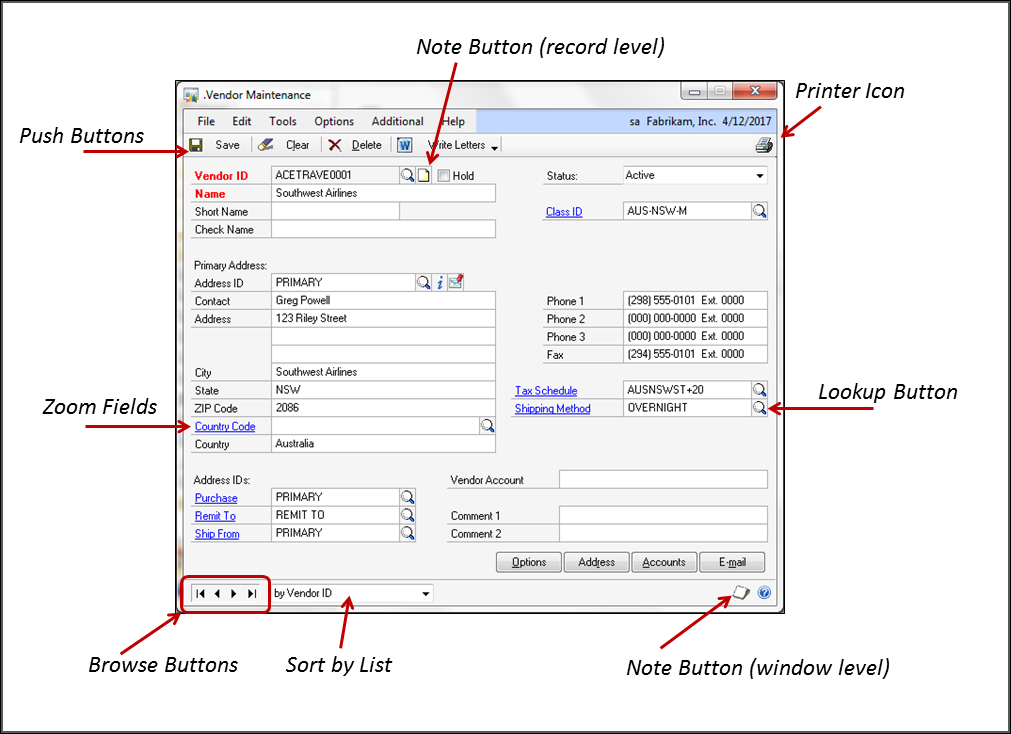If you intend to create a user experience, you need to know the design standards so that you can build your interface to appear and behave exactly like the native Dynamics GP windows. Changing from the Dynamics GP native windows to your windows must be seamless. The "look and feel" must be identical.
Just how tall is that Save button? How wide is it supposed to be? What is expected from a scrolling window or a lookup window? Have you provided for the addition of a record note or a Linked Lookup? Can you add records "on the fly"? Did you include scroll buttons and expansion buttons?
Not only must your application be bug free, it also needs to be free of distractions such as fat buttons and strange icons. Fortunately, you do not have to guess the answers to the earlier questions. Dynamics GP has each of the properties spec'd out for you. In Appendix F of the Dexterity Basics training manual, the user interface guidelines are covered in detail. Depending on the enhancement plan you've signed up for, you can download the Dexterity Basics training manual from http://tinyurl.com/btpbnk7. Contact your partner regarding how to acquire the Dexterity Basics training manual if you cannot download it.
For now, let's review some of the more common window elements that users expect to find on a window. The following image shows the Vendor Maintenance window with some of its window elements highlighted.

A description of each of the highlighted controls is as follows:
Push buttons appear in the window's control area. Push buttons define actions that you can perform on the record displayed. Depending on the type of window, the buttons expected are as follows:
|
Window type |
Buttons |
|---|---|
|
Maintenance |
Save, Clear, Delete |
|
Transaction |
Save, Delete, Void, Post |
|
Inquiry |
OK, Redisplay |
|
Non-modal Dialog |
OK, Cancel |
|
Modal Dialog |
OK |
Record-level notes are big text fields that will hold up to 32,000 characters. The note icon will change appearance to indicate the presence of a note (as shown in the following screenshot). Record-level notes pertaining to all records are typically centrally stored in the company database in the Record Notes Master table (SY03900).

For any given window, a button should typically be available that will print a list report containing the contents of the window. This is the same report that prints from the File | Print command when navigating the user interface.
These fields allow a user to drill down to a lower level of detail from the current window. You can identify a zoom field by the blue underlined prompt. When the mouse passes over a zoom field it turns into a zoom pointer. If the field is a master record, the zoom typically goes to a setup or maintenance window for that item. If the zoom field is a financial field, the zoom navigation is normally from a summary level to a more detailed level.
The following screenshot highlights the zoom pointer and the blue underlined prompt:

Pressing a lookup button should open a lookup window that contains a listing of records. You select a record on the lookup window and that value will be returned to the originating window. For example, the Lookup button next to the Customer Number on the Customer Maintenance window will open the Customers Lookup window. Selecting a customer from the lookup list will bring the selected customer's information back into the Customer Maintenance window.
Browse buttons provide a means of navigation between records in the table. The left-most button will take you to the first record in the table. The right-most button will take you to the last record in the table. The two inner buttons will navigate forward or backward one record at a time.
Next to the browse buttons, you will normally find a list field that is used to sort by a stated criteria . There is usually one record listed for each key in the table. Choosing a specific sort-by will set the table so that the records scroll according to the key you have selected, and the records will be listed in that order when displayed in the lookup window.
The following screenshot highlights the sort-by list:

Window-level notes provide a place to store information regarding a window. The notes are stored by company so that two companies do not share the same set of window notes even though they each have a similar window. For example, each company has a Vendor Maintenance window, but the two windows do not retrieve the same notes.
Window notes provide an excellent place for the user to document instructions on the proper way to fill out a window, to document naming conventions such as Vendor, Customer IDs, and so on. While this element may not directly relate to the functionality of your application, it's one of the elements a Dynamics GP user has come to expect. The icon changes to an image with lines on it when a window note is present.
The following screenshot highlights what the icon looks like when a note is present:




